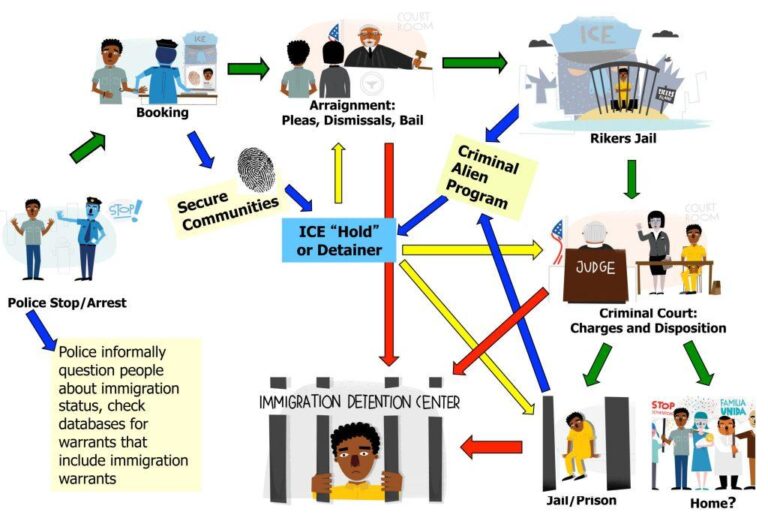The Criminal Alien Program, overseen by U.S. Immigration and Customs Enforcement (ICE), plays a pivotal role in identifying, apprehending, and removing non-citizens who have violated federal immigration laws and committed criminal offenses. As part of the Department of Homeland Security’s efforts to ensure public safety, this program targets individuals with criminal records residing unlawfully in the United States. Through collaboration with local law enforcement agencies, the Criminal Alien Program aims to disrupt criminal activity and uphold the rule of law, highlighting ICE’s commitment to national security and community protection.
Overview of the Criminal Alien Program and Its Enforcement Strategies
The program targets individuals who pose significant threats to public safety by focusing on the identification, apprehension, and removal of criminal aliens residing in the United States. Leveraging a robust partnership network that includes federal, state, and local agencies, enforcement operations are strategically coordinated to enhance the efficiency and impact of arrests and deportations. These efforts are underpinned by detailed intelligence gathering and risk assessment to prioritize cases involving serious offenders, such as those convicted of violent crimes, drug trafficking, and other felonies.
Key enforcement strategies include:
- Targeted Collaboration: Working closely with law enforcement agencies through joint task forces to share information and resources.
- Proactive Field Operations: Conducting searches and arrests in communities to disrupt criminal networks and reduce public safety risks.
- Data-Driven Prioritization: Utilizing criminal history databases and biometric systems to accurately identify high-risk individuals.
| Enforcement Component | Primary Function | Outcome Metric |
|---|---|---|
| Investigations | Case development and intelligence gathering | Number of cases referred |
| Arrests | Execution of detentions and apprehensions | Arrests made per quarter |
| Removals | Deportation of convicted individuals | Successful removals |
Impact of the Program on Community Safety and Immigration Policy
The program has significantly strengthened community safety by prioritizing the removal of criminal aliens who pose a direct threat to public security. Through coordinated efforts with local law enforcement agencies, ICE has effectively identified and detained individuals involved in serious criminal activities, including violent offenses and drug trafficking. This proactive approach not only disrupts criminal networks but also reassures communities by reducing recidivism and improving overall public trust in the justice system.
Key impacts include:
- Enhanced interagency cooperation resulting in quicker apprehensions.
- Reduction in crimes linked to unauthorized immigrants with criminal records.
- Streamlined immigration enforcement policies that align with national security goals.
| Year | Criminal Aliens Removed | Local Agency Partnerships | Reduction in Community Crime (%) |
|---|---|---|---|
| 2021 | 15,342 | 85 | 12% |
| 2022 | 17,890 | 92 | 15% |
| 2023 | 19,457 | 99 | 18% |
Challenges and Criticisms Surrounding the Criminal Alien Program
Despite its stated objectives, the program has faced numerous challenges and criticisms from various stakeholders. Advocacy groups and civil rights organizations argue that the program sometimes results in the disproportionate targeting of Latino communities, further fueling concerns about racial profiling and violations of due process rights. Additionally, questions surrounding transparency and accountability have been raised, as some critics contend that the details of detainee treatment and the criteria for enforcement actions are not always publicly available. These challenges complicate the balancing act between national security priorities and the protection of individual liberties.
Operational hurdles also persist within the implementation framework. Law enforcement agencies grapple with:
- Resource limitations that impact the timely processing of cases.
- Interagency coordination issues, especially between federal and local jurisdictions.
- Legal battles that frequently delay deportations and hinder enforcement efforts.
These factors contribute to a complex environment where policy goals are frequently at odds with logistical realities, resulting in a program that is continually evolving yet perpetually under scrutiny.
Recommendations for Enhancing Transparency and Accountability in ICE Operations
To ensure greater transparency in ICE operations, it is essential to implement standardized public reporting mechanisms that provide timely and detailed updates on enforcement activities. These reports should include metrics such as the number of arrests, demographic data, and outcomes of investigations, allowing the public and oversight bodies to monitor the agency’s adherence to legal and ethical standards. Additionally, establishing independent review boards with the authority to audit and evaluate ICE procedures will foster accountability and build trust within communities affected by immigration enforcement.
Key measures to enhance accountability include:
- Mandatory body camera usage for all field agents during arrests and detentions
- Regular training on civil rights and cultural sensitivity for ICE personnel
- Transparent complaint and investigation processes accessible to the public
- Collaborative partnerships with local governments to align enforcement with community priorities
- Publishing annual performance audits with actionable recommendations
| Transparency Element | Expected Outcome | Implementation Timeline |
|---|---|---|
| Public Reporting Dashboard | Real-time data access for public stakeholders | Within 12 months |
| Independent Oversight Committee | Unbiased operational reviews | 6-9 months |
| Agent Body Cameras | Enhanced evidence collection and accountability | 18 months |
Future Outlook
In summary, the Criminal Alien Program remains a pivotal component of U.S. Immigration and Customs Enforcement’s efforts to identify, apprehend, and remove individuals who pose a threat to public safety. As the program continues to evolve, its impact on immigration enforcement and community security underscores the ongoing challenges and complexities inherent in managing national borders. Monitoring its developments will be essential for understanding the broader landscape of immigration policy and enforcement in the United States.




